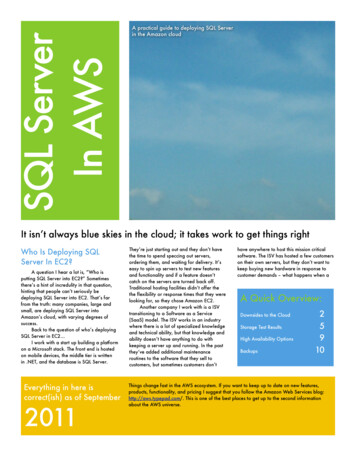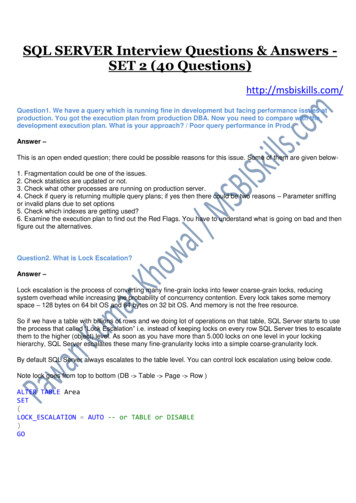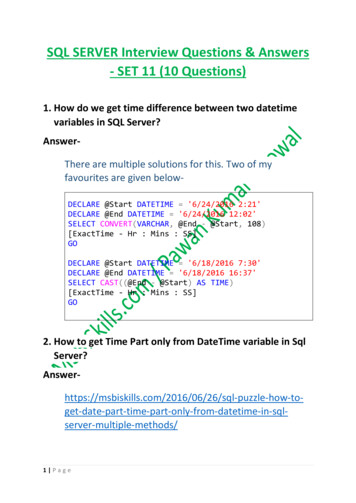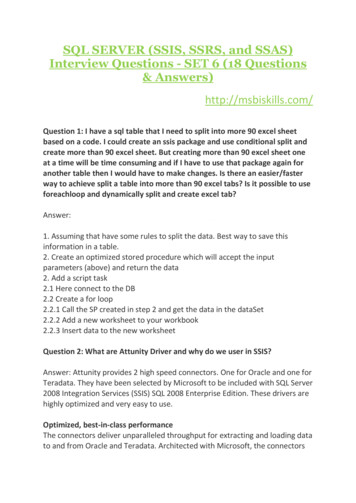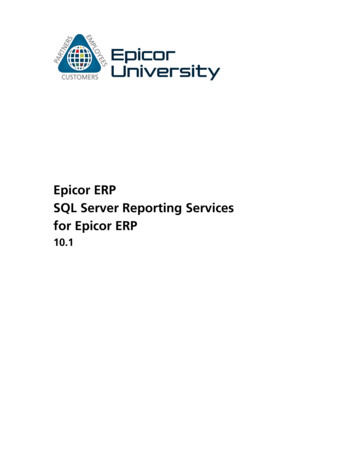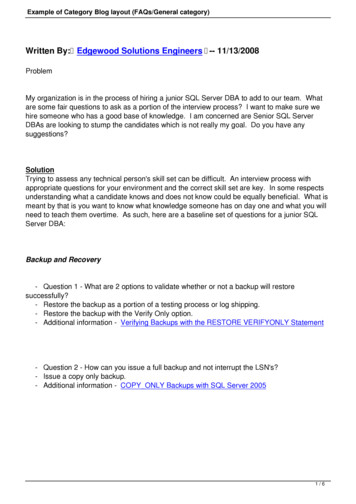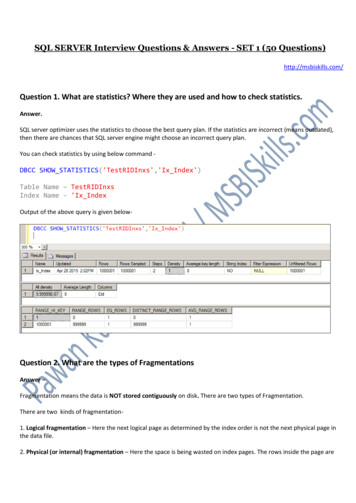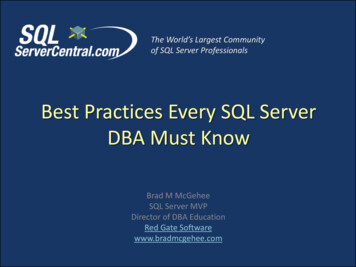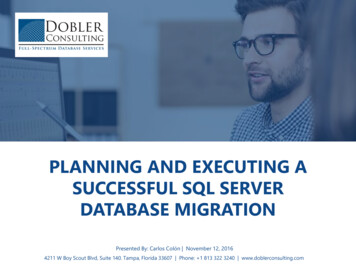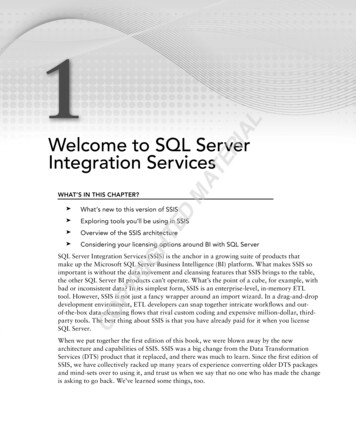
Transcription
AL1wHAT’S IN THIS CHAPTER?MATERIWelcome to SQL ServerIntegration ServicesWhat’s new to this version of SSIS Exploring tools you’ll be using in SSIS Overview of the SSIS architecture Considering your licensing options around BI with SQL ServerGHTED COPYRISQL Server Integration Services (SSIS) is the anchor in a growing suite of products thatmake up the Microsoft SQL Server Business Intelligence (BI) platform. What makes SSIS soimportant is without the data movement and cleansing features that SSIS brings to the table,the other SQL Server BI products can’t operate. What’s the point of a cube, for example, withbad or inconsistent data? In its simplest form, SSIS is an enterprise-level, in-memory ETLtool. However, SSIS is not just a fancy wrapper around an import wizard. In a drag-and-dropdevelopment environment, ETL developers can snap together intricate workflows and outof-the-box data-cleansing flows that rival custom coding and expensive million-dollar, thirdparty tools. The best thing about SSIS is that you have already paid for it when you licenseSQL Server.When we put together the fi rst edition of this book, we were blown away by the newarchitecture and capabilities of SSIS. SSIS was a big change from the Data TransformationServices (DTS) product that it replaced, and there was much to learn. Since the fi rst edition ofSSIS, we have collectively racked up many years of experience converting older DTS packagesand mind-sets over to using it, and trust us when we say that no one who has made the changeis asking to go back. We’ve learned some things, too.
2 CHAPTER 1 Welcome to SQL Server Integration ServicesWhile SQL Server 2012 was a large jump forward for SSIS, SQL Server 2014 has some very smalliterative changes. When we wrote this book, we dug deeply to mine the decades of cumulativeexperience working with this product, adding our collective knowledge back into these pages. Wehope you will agree that the result makes your experience with SSIS a more productive one. Thischapter starts from the beginning by providing an overview of SSIS, describing where it fits withinthe BI product platform and ETL development in general.SQL Server SSIS Historical OverviewIn SQL Server 7.0, Microsoft had a small team of developers work on a very understated featureof SQL Server called Data Transformation Services (DTS). DTS was the backbone of the Import/Export Wizard, and its primary purpose was to transform data from almost any OLE DB–compliant data source to almost any destination. It also had the ability to execute programs and runscripts, making workflow a minor feature.By the time that SQL Server 2000 was released, DTS had a strong following of DBAs and maybea few developers. Microsoft included in the release new features like the Dynamic Properties Taskthat enabled you to alter the package dynamically at runtime. Even though DTS utilized extensivelogging along with simple and complex multiphase data pumps, usability studies still showed thatdevelopers had to create elaborate scripts to extend DTS to get what they wanted done. A typicaluse case was enabling DTS to load data conditionally based on the existence of a file. To accomplishthis in DTS, you had to use the ActiveX Script Task to code a solution using the file system objectin VBScript. The problem with that was DTS lacked some of the common components needed tosupport typical ETL processes. Although it was powerful if you knew how to write scripting code,most DBAs didn’t have this type of scripting experience (or time).After five years, Microsoft released the much-touted SQL Server 2005 and SSIS, which was nolonger an understated feature like DTS. With the SQL Server 2008 release, SSIS was given extrascalability features to help it appeal more to the enterprise. This is entirely appropriate becauseso much has been added to SSIS. Microsoft made a huge investment in usability, with simpleenhancements to the toolbox that allow newer users to ramp up easier. The main focus of the newestrelease of SQL Server is on the management and deployment of SSIS.What’s New in SSISThe scope of the SQL Server 2014 release of SSIS resembles the scope of the SQL Server 2008 R2release. With the last release of SQL Server 2008 R2, the Microsoft SSIS team did very incrementalchanges after a very large SQL Server 2008 release. In SQL Server 2012 release, Microsoft hadfocused on SSIS manageability, making it easier to deploy and execute. Also added in 2012 arerobust new data cleansing components that help you standardize and detect data anomalies.Furthermore, improvements to the development tools will help make SSIS developers moreproductive and help new developers get up to speed more easily. The SQL Server 2014 release usesa newer version of Visual Studio but all in all, it will feel much like SQL Server 2012. You will findnew components in SQL Server 2014 SSIS, but they will have to be downloaded from sites likeCodePlex from the product team and will eventually be rolled into the core product at a future release.
Tools of the Trade 3Tools of the TradeMost of this book will assume that you know nothing about previous releases of SQL Server SSIS.Instead, it takes a fresh look at SQL Server SSIS. The learning curve can be considered steep at first,but once you figure out the basics, you’ll be creating complex packages in no time. To provide anidea of how easy SSIS is to use, the following section looks at a staple tool in the ETL world:the Import and Export Wizard.Import and Export WizardIf you need to move data quickly from almost any OLE DB–compliant data source or flat file to adestination, you can use the SSIS Import and Export Wizard (shown in Figure 1-1). In fact, manySSIS packages are born this way, but most packages you wish to keep in a BI solution should notbe created with the wizard. The wizard provides a quick way to move data and perform very lighttransformations of data but does not create packages that use best practices. The wizard is availablein all editions of SQL Server except the Local Database edition and Express. It enables you to persistthe logic of the data movement into a package file. The basic concept of an import/export wizardhas not changed substantially from the days of DTS. You still have the option to check all the tablesyou want to transfer. In addition, however, you can also encapsulate the entire transfer of data intoa single transaction.Where do you find the wizard? It depends. If you just need to perform a quick import or export,access the wizard directly from the Start menu by navigating to Start Microsoft SQL Server“2014” Import and Export Data. The other option is to open a project in the SSIS developmentenvironment and select Project SSIS Import and Export Wizard. We cover this in detail inChapter 2. Before we get into all the mechanics for that, see Figure 1-1 for an example of the wizardthat has bulk loaded tables.Figure 1-1
4 CHAPTER 1 Welcome to SQL Server Integration ServicesThe SQL Server Data Tools ExperienceThe SQL Server Data Tools (SSDT) was previously called Business Intelligence Development Studio(BIDS) in SQL Server 2008, and it is the central environment in which you’ll spend most of yourtime as an SSIS developer. SSDT is just a specialized use of the familiar Visual Studio developmentenvironment. In SQL Server 2014, SSDT no longer installs when you install SQL Server. Instead,you’ll have to download and install the SQL Server Data Tools (Business Intelligence for VisualStudio) from the Microsoft website. At the time of this publication, SQL Server 2014 can usethe Visual Studio 2012 and 2013 versions to design SSIS packages. Visual Studio can host manydifferent project types, from Console applications to Class Libraries and Windows applications.Although you may see many project types when you create a project, SSDT actually containsproject templates for only Analysis Services, Integration Services, Report Server, and variantsthereof. SSIS in particular uses a BI project type called an Integration Services project(see Figure 1-2), which provides a development design surface with a completely ETL-based set oftools in the Toolbox window.Figure 1-2This development environment is similar to the legacy DTS Designer, but the approach is completelydifferent. Most important, this is a collaborative development environment just like any VisualStudio development effort, with full source code management, version control, and multi-userproject management. SSIS solutions are developed just like all other .NET development solutions,including being persisted to files — in this case, XML file structures with a .DSTX file extension.
SSIS Architecture 5You can even develop within the SSDT environment without a connection to a SQL Serverinstance using the offline mode. Once your solution is complete, it can be built and deployed toone or multiple target SQL servers. These changes from DTS to SSIS are crucial to establishingthe discipline and best practices of existing software development methodologies as you developbusiness intelligence solutions. We’ll discuss this SSDT development interface in more detail inChapter 2.SSIS ArchitectureMicrosoft has truly established SSIS as a major player in the extraction, transformation, and loading(ETL) market. Not only is the SSIS technology a complete code rewrite from SQL Server 2000 DTS,it now rivals other third-party ETL tools that can cost hundreds of thousands of dollars dependingon how you scale the software — and it is included free with the purchase of SQL Server 2014. Freealways sounds great, but most free products can take you only so far if the feature set is minimal orthe toolset has usability, scalability, or enterprise performance limitations. SSIS, however, is the realdeal, satisfying typical ETL requirements with an architecture that has evolved dramatically fromearlier incarnations. At the time of this publication, SSIS held the world speed record of loadingmore than 2 terabytes in a single hour.PackagesA core component of SSIS is the notion of a package. A package best parallels an executableprogram that you can write that contains workflow and business logic. Essentially, a packageis a collection of tasks snapped together to execute in an orderly fashion. A package is also aunit of execution and development, much like a .NET developer creates programs or DLL files.Precedence constraints are used to connect the tasks together and manage the order in which theyexecute, based on what happens in each task or based on rules defined by the package developer.The package is brought together into a .DTSX file that is actually an XML-structured file withcollections of properties. Just like other .NET projects, the file-based code is marked up using thedevelopment environment and can then be saved and deployed to a SQL Server.Don’t worry; you won’t have to know how to write this type of XML to create a package. That’swhat the designer is for. The point here is that the SSIS package is an XML-structured file, muchlike .RDL files are to Reporting Services. Of course, there is much more to packages than that, andyou’ll explore the other elements of packages, such as event handlers, later in this chapter.Control FlowThe brain of a package is its Control Flow, which orchestrates the order of execution for all itscomponents. The components consist of tasks and containers and are controlled by precedenceconstraints, discussed later in this chapter. For example, Figure 1-3 shows three tasks that are tiedtogether with two precedence constraints.
6 CHAPTER 1 Welcome to SQL Server Integration ServicesFigure 1-3TasksA task can best be described as an individual unit of work. Tasks provide functionality to yourpackage, in much the same way that a method does in a programming language. However, in SSIS,you aren’t coding the methods; rather, you are dragging and dropping them onto a design surfaceand configuring them. You can develop your own tasks, but here are the current ETL tasks availableto you out of the box: Analysis Services Execute DDL Task: Executes a DDL Task in Analysis Services. Forexample, this can create, drop, or alter a cube (Enterprise and Developer Editions only). Analysis Services Processing Task: This task processes a SQL Server Analysis Services cube,dimension, or mining model. Bulk Insert Task: Loads data into a table by using the BULK INSERT SQL command. CDC Control Task: Maintains and interacts with the change data capture (CDC) featurefrom SQL Server. Data Flow Task: This very specialized task loads and transforms data into an OLE DB andADO.NET destination. Data Mining Query Task: Allows you to run predictive queries against your AnalysisServices data-mining models. Data Profiling Task: This exciting task enables the examination of data; it replaces your adhoc data profiling techniques.
SSIS Architecture 7 Execute Package Task: Allows you to execute a package from within a package, makingyour SSIS packages modular. Execute Process Task: Executes a program external to your package, such as one to splityour extract file into many files before processing the individual files. Execute SQL Task: Executes a SQL statement or stored procedure. Expression Task: Sets a variable to an expression at runtime. File System Task: This task can handle directory operations such as creating, renaming, ordeleting a directory. It can also manage file operations such as moving, copying, or deletingfiles. FTP Task: Sends or receives files from an FTP site. Message Queue Task: Sends or receives messages from a Microsoft Message Queue(MSMQ). Script Task: This task enables you to perform .NET-based scripting in the Visual StudioTools for Applications programming environment. Send Mail Task: Sends a mail message through SMTP. Web Service Task: Executes a method on a web service. WMI Data Reader Task: This task can run WQL queries against the Windows ManagementInstrumentation. T
The scope of the SQL Server 2014 release of SSIS resembles the scope of the SQL Server 2008 R2 release. With the last release of SQL Server 2008 R2, the Microsoft SSIS team did very incremental changes after a very large SQL Server 2008 release. In SQL Server 2012 release, Microsoft had focused on SSIS manageability, making it easier to deploy and execute. Also added in 2012 are robust new .



